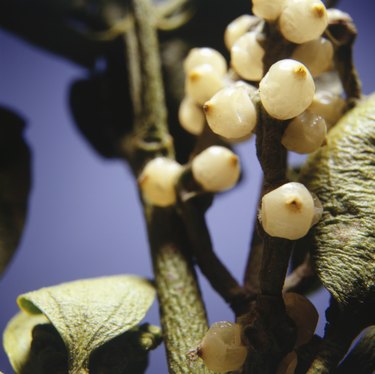
Mistletoe is a parasitic plant that grows on trees, stealing water and nutrients from them by embedding its root system inside its host. There are two types of mistletoe. Dwarf mistletoe attacks pine trees, firs and conifers while true mistletoe attacks a variety of trees, including oaks, elms, pecans, birch, ash, walnuts, box elders, locusts and white fir. There aren't any sprays that will kill mistletoe without also hurting the host tree, but there are other ways to control this nuisance plant.
True Mistletoe
Video of the Day
True mistletoe, or leafy mistletoe, is an evergreen plant with thick, oval leaves and small, whitish berries that grows between October and December. True mistletoe often grows in clumps and is easy to see after trees drop their leaves in the autumn. True mistletoe plants can only survive on living hosts. They produce most of their own food, but they do draw some nutrients and a lot of water from the host tree.
Video of the Day
Dwarf Mistletoe
Dwarf mistletoe causes a lot more damage to its host because it doesn't produce any of its own food through photosynthesis. Dwarf mistletoe is smaller than true mistletoe, with non-woody, segmented shoots and small, scale-like leaves. Like true mistletoe, dwarf mistletoe can only survive on living hosts.
Damage
Healthy trees can usually tolerate true mistletoe on a few of their branches because just a few plants don't remove enough water or mineral nutrients to cause significant damage. However, a severe infestation can kill trees, especially if they're already stressed or weakened for other reasons. True mistletoe causes swollen and brittle areas of dead wood. Trees that are infested with dwarf mistletoe lose vigor and die slowly from the top down as their food supply is gradually choked off. As the infestation grows worse, trees become twisted and blackened. Both types of mistletoe cause a dense growth of small branches called witch's broom.
Clipping
Mistletoe attaches itself to a tree's vascular system, and the only way to permanently remove it from a tree is to remove part of the tree as well. Clipping off the visible part of the mistletoe won't remove all of the plant; it will just grow back. However, clipping the mistletoe back to the point where it emerges from the tree does mean it won't draw as much water or nutrients from its host, and it may also keep the mistletoe from flowering. This will need to be repeated every year or two to keep the mistletoe under control.
Pruning
Pruning infested branches will entirely remove mistletoe and kill it. Cut the branch at a crotch at least 1 foot from the spot where the mistletoe is growing. Pruned branches don't need to be destroyed since the mistletoe will naturally die once it's no longer on a living host. Pruning is effective on lightly infested trees, but it may be impossible to prune all of the infected branches on severely infested trees without killing them.
Ethephon
Ethephon is a chemical that regulates plant growth. When used on mistletoe, it causes the mistletoe to drop most of its flowers, fruit and shoots, preventing the plant from going to seed and spreading the infection to other trees. However, it doesn't kill the part of the root system that's in the host tree, so the plant re-grows in three to five years. Ethephon can be used to help control dwarf mistletoe or true mistletoe and should be applied when the host tree is dormant.
- USDA Forest Service: The Mistletoe Center
- Fort Valley State University: Mistletoe in Trees
- Mississippi State University Plant Pathology InfoBytes: Mistletoe in Landscape Trees
- University of Arizona Backyard Gardener: "The Truth About True Mistletoe"; Jeff Schalau; April 2008
- Game Trail Homeowner’s Association: Homeowner’s Guide To Dwarf Mistletoe Management
- UniversityofCaliforniaatDavisIntegratedPestManagement Program: Mistletoe